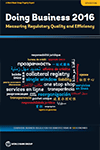Overview
Over the past five years 37 economies computerized their land registry. The average time required to register a property transfer in these economies fell by almost 40% while the global average only decreased by 7%. The transition from a paper-based land administration system to a digital one involves several considerations, including the legal framework, technological capabilities, and human and social factors. Once an appropriate legal framework and data system have been established, the land records can be converted into a digital format so that they are properly stored and protected from the effects of time (excessive use, moisture) or even natural disasters (floods, earthquakes). Beyond going digital, land registries can develop new services and be connected to other agencies.
Main Findings
- Over the past five years 37 economies computerized their land registry.
- In the economies that digitized their registry, the time required to transfer property has fallen by 38% since 2011. In those that did not, the time has decreased by only 7%.
- Before making the transition to a digital land registry, policy makers need to take into account such considerations as the legal framework, technological capabilities, and human and social factors.
- Going digital can be done in several steps—starting with computerization of the registry and moving on to fully online registration of immovable property.
- Beyond going digital, land registries can develop new services—such as mobile applications and interconnection with other agencies.

